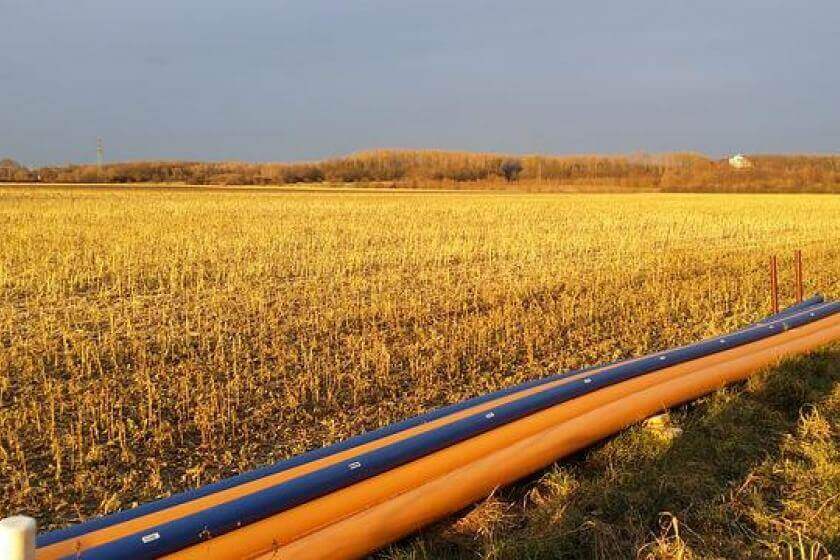Articles
Sample Articles from Bob Wallace.
Read More about Bob.
Retailers Explore Drone Delivery Options as Market for Faster Fulfillment Emerges
- Details
- Published on 02 September 2022

(Source: Pixabay)
Early implementers favor partnerships over Amazon’s expansive, do-it-yourself model. What are the top considerations for IT leaders?
Retailers Walmart and Walgreens continue to move forward with drone delivery services, even as innovator Amazon has yet to launch its decade-in-the-making offering.
That is because enterprises are evaluating drone delivery alternatives to time and resource-intensive DIY internal efforts that allow IT managers in retail to get running and valuable experience faster.
Drone delivery progress report
Amazon rival Walmart has been delivering items from select stores in its home state of Arkansas via drone for a year through a partnership with innovator DroneUp, a drone delivery flight services provider. Another competitor, Alphabet’s Wing, launched commercial drone deliveries in Texas in April with customer Walgreens pharmacies.
In late May, David Guggina, Senior Vice President of Innovation and Automation, Walmart U.S., announced in a blog that Walmart-DroneUp would be expanding its delivery network partner to 34 sites by yearend. This provides "the potential to reach 4 million U.S. households across six states – Arizona, Arkansas, Florida, Texas, Utah, and Virginia. This provides us the ability to deliver over one million packages by drone in a year."
The drone opportunity
Drone package delivery is alive and well, according to a team of experts at McKinsey’s Aerospace & Defense Practice, who has been tracking its emergence on a global level and have identified three keys to those looking to launch.
“The industry is real and booming,” according to the McKinsey team. “Over the past three years, there have been over 660,000 commercial drone deliveries to customers, not including the countless test flights to develop and prove the technology.”
In fact, the team wrote, drone deliveries had become a daily occurrence. “As of early 2022, we estimate that more than 2,000 drone deliveries are occurring each day worldwide. The growth rate is accelerating every week, and we project that there will be close to 1.5 million deliveries in 2022, up from just under half a million in 2021.”
Critical juncture
While drone package deliveries are growing, and important indicators are positive, the management consulting firm sounded words of caution about the road ahead.
“We are at a critical time in the drone delivery industry. Volume has grown dramatically in recent years, but the path ahead is not yet clear,” according to McKinsey. “Regulations, customer acceptance, and cost will all determine whether the industry reaches its potential to disrupt global logistics or remains limited to isolated applications.”
Key factors for enterprise IT leaders:
1) Regulatory landscape
The regulatory landscape can make or break an enterprise’s drone delivery undertaking by dictating the scale and scope of the operations.
“Regulation dictates the type of operations allowed, including parameters related to geographic areas and airspace, times of day, and the conditions required for flight. All these factors can have a large impact on costs,” according to the McKinsey team.
“Regulation can determine or limit one of the key costs of launching drone delivery, the operator-to-drone ratio. There is a big cost difference if, for example, regulations require one operator for each drone or allow a single operator to control a dozen or more drones.” Regulations also determine airworthiness requirements for drones, and the guidelines could potentially increase costs and delay at-scale operations, the McKinsey team wrote.
2) Public reaction (and acceptance?)
Another gating factor in the launch of a drone delivery service is the need to gain the public's trust and acceptance of drone delivery (and maintain it). New ways of doing business in towns and cities for visible approaches like drone delivery can evoke concerns by consumers.
The firm explained that actual adoption is likely to differ across neighborhoods depending on a variety of factors, including population density, geographic location, and local weather conditions.
3) Cost(s)
Consumers will favor deliveries with the lowest cost if all other factors are equal. While drone deliveries have grown markedly worldwide in the last few years, some only extend one mile from stores, as is the case with Walmart's program with DroneUp, as per FAA regulations.
4) Technology
Drone deliveries only go as far as a blend of technologies can take them. IT managers in retail and beyond need to plan accordingly as few have the deep pockets and technical resources committed to Amazon’s undertaking.
The serial innovator has built many sophisticated delivery platforms. In a website posting dated June 13, the company claimed to have “created more than two dozen (drone) prototypes.”
Further, Amazon has gone far beyond creating delivery drones themselves by building an advanced sense-and-avoid system to make air operations safer during flight.
Drones and the 5G advantage
The emergence of 5G networks can boost the operational efficiency of drones, according to Adam Schink, Senior Manager of Innovation & Scouting at BT Global, in The Future of Innovation: How 5G Is Pushing Drone Technology Forward.
“A connection to a 5G network means a drone can send information back to base in real time. Early drone technology meant all the information from drone-mounted cameras, sensors and telemetry could only be uploaded from the drone’s hard drive once it had landed,” Schink wrote. A 5G connection changes all that and opens new possibilities.
5 Challenges for Enterprises Considering LEO Satellite Services
- Details
- Published on 29 August 2022

(Source: Pixabay)
The fast-growing sector may have businesses looking elsewhere to alternatives with faster options to expand networks to remote offices and WFH residences.
For those who looked skyward for solutions to problems here on Earth, Low-Earth Orbit (LEO) satellite operators promise to deliver high-speed Internet around the world as part of a new era high stakes space race.
The entry of SpaceX and Amazon into the low-earth orbit satellite business, combined with their televised manned rocket rides to space, showed what could be accomplished by some of the richest men on Earth, Elon Musk of SpaceX and Amazon's Jeff Bezos.
The business of tech
But ironically, the economics of launching vast fleets of satellites into low Earth orbit to deliver lower latency and affordable price have many wondering if and why they should be looking to the option for help connecting businesses and homes with Internet here on Earth.
That leaves IT managers to evaluate LEO services offered by SpaceX (with an estimated 2,200 birds in flight for its Starlink service) and promised by Amazon Project Kuiper, which has yet to launch a single LEO bird*) for viability now as an option for serving a remote workforce comprising remote offices and home workers.
A SpaceX Starlink update
When we last visited this space last November, the Starlink service was in beta, leaving a few veteran providers such as Viasat, HughesNet, and OneWeb to serve interested enterprises and consumers. But now we have pricing from SpaceX for business and residential users, pricing that could hurt slow adoption.
Starlink Residential costs $100 a month and a one-time $599 charge for the dish and a Wi-Fi router. The equipment comes in a kit for subscribers to install, which requires a clear line of sight to the sky. Latency (a big selling point for satellite services) will be largely under 20 milliseconds. Supported data throughput is roughly 100Mbps for the downlink but much less for the return path.
Starlink Business, set to serve up to 20 users at an office, costs $500 a month with a one-time $2,500 dish and CPE charge that, like residential, comes in a self-install kit. Latency will be between 20-40 milliseconds with an expected download speed of between 150-350 Mbps. Customers must download the Starlink app to get underway. There are no long-term contracts or caps on usage.
The challenges
Price problems
“That seems a bit pricey relative to business-class cable and fiber offerings. But then again, when it is your only viable option, then you’ll pay the money,” explained Jeff Heynen, VP of Broadband Access and Home Networking for Dell’Oro Group, a global market research and advisory services company. “I suspect the LEOs will continue to expand their service offerings and applicability to businesses and end customers beyond residential, but cost remains a barrier to entry for now.”
Competition on Earth
While LEO satellite service providers are working on launching constellations of satellites, it's no secret that federally funded, nationwide broadband rollout enabled by the Biden Administration's Infrastructure and Jobs Act already has hundreds of millions in funding headed to states. It will bankroll statewide broadband deployments by service providers to connect a huge part of LEO operators' target customers – underserved and unserved locations, most located in rural areas.
The problem here is that carriers' expansion media options, fiber, and fixed microwave access (FWA) can offer higher speeds than the LEO technology and may reach customers sooner.
Broadband cable systems also offer speed competition to LEO services and the added benefit of already operating distribution systems with large residential and business reach outside metro areas.
Reliability issues
With incomplete LEO satellite fleets par for the course, the issues of resulting downtime present a concern for enterprises. Downtime is money, and more, so IT managers need to press for strong service-level agreements (SLA) to avoid service interruptions with compensation for unavailability. Heynen advises enterprise IT managers not to subscribe without them.
Geographic coverage
Coverage will improve with more LEO satellite launches. At present, Starlink service is not available in large swaths of the U.S. Other LEO satellite operators, including Viasat and OneWeb, are expanding deployment of the birds to expand geographic coverage around the world.
Accurate coverage maps will play a crucial role in enterprise IT’s interest in LEO satellite services since service regions vary by provider.
Disputes between operators
Although disputes can slow the rollout of new and current services, it’s unclear if and how a dispute between DISH Networks and SpaceX over spectrum use will impact either.
At issue is SpaceX's claim to the FCC that DISH's use of spectrum in the 12Ghz auction would interfere with Musk's LEO satellite service. DISH seeks to now use the spectrum it paid for video and data distribution service to launch a 5G wireless network service. DISH claims the use of Starlink service on mobile vehicles should lead to service deactivation by the FCC if SpaceX doesn't. Stay tuned.
The bottom line
When compared to traditional satellites in higher, geosynchronous orbit, LEOs fare much better when it comes to latency and speed. But since they do have limitations on the bandwidth they can offer, Heynen believes LEOs are a viable option in cases where fixed broadband operations are limited or unavailable. That’s not to say IT managers shouldn’t keep tabs on this emerging operator service sector as those LEO providers get closer to full satellite fleet deployment and farther from initial launches.
*NOTE: In 2020, the FCC issued Amazon a license that requires Amazon to launch at least half of its planned 3,236-satellite constellation by 2026.
Related articles:
Carriers, Vendors Adjust Supply Chain Processes to Aid Broadband Rollouts
- Details
- Published on 09 August 2022

(Source: Pixabay)
Tens of billions in infrastructure funding are being distributed to close the digital divide, but will certain short-term changes result in problems down the road for all parties?
Aiming to provide enterprise customers with expanded and enriched broadband networks to reach new sites and home workers during challenging times, carriers and their vendors are reworking longstanding practices to skirt weak supply chain links.
Tens of billions in federal funding are earmarked for the telecom industry’s largest ever infrastructure undertaking. The focus is on closing the digital divide and introducing high-speed services using next-generation fiber technologies.
But supply chain woes, chip shortages, and more have some carriers changing the way they acquire broadband infrastructure from equipment suppliers to advance their high-speed Internet service rollouts during a time of mounting frustration.
Current delay situation
When you combine delays in fiber optics, the resin that surrounds them, and the electronics for fiber broadband, carriers are experiencing 52-week lead times, according to Gary Bolton, President of the Fiber Broadband Association (FBA). The group held its annual conference in June and turned away over one hundred exhibitors.
Bolton said 52 weeks is workable for companies that plan their fiber deployments carefully. By the time they apply for a government grant, design their networks, and do other planning, they are going to need at least 52 weeks, anyway.
Rush to cash in
The allure of the largest ever broadband breakout has caught the attention of the telecom industry and enterprise IT. Carriers hope – sooner rather than later - to interest enterprises in expanding and upgrading their corporate networks to reach new offices and support work-from-home efforts as the telecom industry tires of rolling delays from supply chain issues. The waiting is the hardest part.
“Investment in next-generation fiber technologies has skyrocketed over the last four years,” explained Jeff Heynen, VP of Broadband Access and Home Networking for Dell’Oro Group, a market research and advisory services firm. “Broadband service margins remain incredibly strong, providing additional incentives for multi-gigabit service rollouts. Fiber plans have been pushed forward to help (upgrade) access networks.”
Shortening the acquisition process
Non-traditional acquisition processes have taken root. Instead of first apprising vendors of their gear needs in "forecasts," to vendors, Consolidated Communications has dropped forecasts and replaced them with actual purchase orders to shorten the process, explained Tom White, CTO of the carrier, which operates in over twenty states from coast to coast. "A purchase order out trumps a forecast all day, every day." Breaking practices helps deal with a 9-12 month wait on electronics and other required components.
Buying big
Ziply Fiber, a carrier providing business and residential services in parts of the Pacific Northwest, has taken Consolidated’s approach a step farther. “We own a lot of real estate and yards behind buildings,” began John Van Oppen, VP of Network for the company. "We fill it up with a parts supply of about 12 months and keep ordering on the back end." Submitting early purchase orders has also helped the carrier, which also uses the process for acquiring fiber. However, both carrier technology executives admit this changed process is not guaranteed to always work, as equipment vendors often receive de-commit notices from the makers of components used in equipment because of their production challenges. This can add three to six months to the availability of broadband networking – everything from fiber CPE to outside plant equipment such as cabinets.
The carrier executives – and others - discussed numerous issues in the Broadband Technology Summit, a multiday event created by Fierce Telecom and the Dell’Oro Group.
Concerns with overbuying
Dell’Oro’s Heynen questioned the long-term merit of overbuying. "This makes me nervous because the overcommitment is likely going to turn into an overshoot once the supply chain issues are resolved. It is called the Snapback Effect, and we are going to see some of that next year. But even if the providers are overbuying to move up the queue for equipment, the vendors still cannot ship to those commitments, which is reflected in the growing backlogs these vendors have reported."
Low inventories, which have been commonplace during Covid-19, provide a potential snapback effect for the economy.
The road ahead?
Heynen is concerned that recent interest rate increases will slow down purchases and whether a percentage of the vendor backlogs would simply go away as providers canceled projects and waited things out. He is convinced that there will be some operators “who just slow roll their buildouts or cancel some fiber overbuild projects that just aren’t strategic enough.”
Targeting small rural carriers that have landed RDOF funding but that typically lack global supply chains, Nokia in June introduced a network-in-a-box package that lets them provide high-speed fiber services to towns with up to 1,000 homes.
Each Nokia Broadband Relief Kit is comprised of the necessary FTTH equipment, software licenses, support, and state-of-the-art in-home Wi-Fi gateways required to serve a typical town of 1,000 households, according to the vendor. The kits support GPON and XGS-PON over a single port and fiber using Nokia’s Multi-PON-Module (MPM) technology.
The kits can support 25G PON today or when the need arises, according to the vendor. The kits are available now and include expedited delivery. Nokia has created twenty-five of these kits.
Households in unserved or underserved areas have been hardest hit by global supply chain shortages of telecommunications equipment as operators planning new gigabit broadband networks have been unable to complete their builds.
While both public and private funds are available in unprecedented quantities, many small operators have found themselves unable to secure the necessary materials from their established supply chains to meet their self-imposed construction schedules or regulatory-imposed milestones.
Manufacturing might
Global cable maker Corning has asserted that manufacturing capacity is a large part of the problem, especially in North America.
CEO Wendell Weeks put it on the company’s Q4 2021 earnings call in January “if we could make more, we could sell more…the real bottleneck is not resin, is not raw materials, is not labor. It is just us being able to get into place capacity that is more appropriately balanced to the demand that we are experiencing.”
To that end, Corning announced plans to build a new optical fiber manufacturing facility in Poland, and in September 2021, said it would spend $150 million to expand its optical cable manufacturing operation in North Carolina.
The new manufacturing facility in Poland is set to become operational this year. That will free up U.S. fiber capacity for U.S. demand, according to Corning. The company’s execs believe Corning and others expanding manufacturing capacity will improve lead times for their carrier customers.
Related articles:
- Putting Broadband Internet on the Map
- What Enterprises Can Expect as Carriers to Spend Billions on Broadband Rollouts
- Telecom Industry Takes the Workforce Challenge to Staff Internet-for-All Broadband Rollout
The DISH-SpaceX 5G Spectrum Dispute; Enterprise Impact and Possible Outcomes
- Details
- Published on 26 July 2022

(Source: Pixabay)
If the FCC rules interference is a concern, spectrum sharing systems could provide a solution for all parties by maximizing the use of the 12GHz band.
In the latest spectrum challenge, Elon Musk's SpaceX claims DISH Networks wants to use the 12 GHz band with its terrestrial 5G network, which would cause harmful interference to his emerging Starlink satellite Internet service. DISH disagrees.
For its part, DISH already has a 5G network and hopes to expand it by moving into the 12 GHz band, which it uses to provide satellite TV service.
In January, the FCC voted to issue a Notice of Proposed Rulemaking (NPRM) seeking comment on ways the 12 GHz band might be better used. The notice sought input on methods for allowing new uses in the band while protecting incumbents.
Both operators have submitted to the FCC technical studies that support their arguments regarding interference. SpaceX’s Musk has successfully urged customers to contact the agency supporting the company’s claim.
DISH continues to claim a 12GHz 5G network can coexist with satellite internet services without generating interference.
Both operators, and much of the telecom industry, await a ruling from the FCC, which has not said when it will act.
Enterprise IT impact
Enterprise IT, however, may not feel a significant impact from the resolution of the challenge. That is unless they seek broader competition in the private 5G wireless network sector or are looking to connect mostly rural sites using Low Earth Orbit (LEO) satellite services.
The broader impact could reach farther if the FCC finds no inference and/or recommends a spectrum sharing approach that could maximize the use of the 12GHz band by all interested parties without fear of interruption.
This appears to have worked well with the Citizens' Broadband Radio Service (CBRS) creation, auction, and diverse spectrum winning bidders, including many enterprises, most looking to build private 5G networks.
Building a spectrum-sharing infrastructure will take time, and that is once the FCC rules on the 12GHz band dispute.
A recent history of 5G service interference concerns
For veteran IT staff, this is but the very latest in a lengthy list of disputes over potential interference caused by shared use of the same spectrum. Most recently was last year’s spike in concern about 5G services offered in the C-band near U.S. airports interfering with altimeters, which are used to gauge elevation in airplanes.
The concerned parties expressing serious concern about harmful interference included the Federal Aviation Administration, CEOs of several airlines, the Department of Transportation, and plane makers. AT&T and Verizon were in opposition to slowing the deployment of 5G near airports. But the carriers eventually agreed in January to delay rollouts by six months while the key players explored the issue.
In June, the FAA announced that key stakeholders in the aviation and wireless industries have identified a series of steps that will continue to protect commercial air travel from disruption by 5G C-band interference while also enabling Verizon and AT&T to enhance service around certain airports.
- The phased approach requires operators of regional aircraft with radio altimeters most susceptible to interference to retrofit them with radio frequency filters by the end of 2022. This work has already begun and will continue on an expedited basis, according to the agency.
- At the same time, the FAA said it worked with the wireless companies to identify airports around which their service can be enhanced with the least risk of disrupting flight schedules.
During initial negotiations in January, the wireless companies offered to keep mitigations in place until July 5, 2022, while they worked with the FAA to better understand the effects of 5G C-band signals on sensitive aviation instruments.
Based on progress achieved during a series of stakeholder roundtable meetings, the wireless companies offered Friday to continue with some level of voluntary mitigations for another year, according to the FAA.
Despite the collaborative efforts to work out a solution, a permanent fix has not yet been created and agreed on.
The CBRS sharing solution
If the FCC and its tech experts are concerned about interference between DISH 5G and SpaceX birds, the situation could be addressed so that neither is shut out of the 12 GHz band. That could be enabled using spectrum sharing, which was used to let carriers, enterprises, and others to concurrently use the 3.5 to 3.7 GHz space alongside longtime users. The 2020 auction made available space to 228 winning bidders and brought the FCC $4.58 billion.
DISH, bidding under the name Wetterhorn Wireless, came in as the second largest total winning bidder, spending over $900 million.
A wireless industry ecosystem, including the FCC, equipment vendors, and those building systems necessary to enable greater spectrum sharing, have been hard at work to prepare the CBRS for a wave of new users. The band is valued at over $15 billion.
The initial commercial deployment of CBRS service was approved by Spectrum Access System (SAS) administrators Amdocs, CommScope, Federated Wireless, Google, and Sony.
Telecom Industry Takes the Workforce Challenge to Staff Internet-for-All Broadband Rollout
- Details
- Published on 30 June 2022

(Source: Pixabay)
Demand for skilled staff is sky high, but not supply, for the largest-ever U.S. infrastructure effort. Associations, carriers, and vendors look to fill the staffing gap as spending on fiber broadband climbs.
With supply chain challenges aplenty in expanding broadband networks, carriers are now facing a workforce shortage in deploying the fiber equipment that they have purchased, especially for the Fed-funded Internet-for-all program.
For those IT managers that were not yet aware of the workforce shortage, which could complicate network expansion plans, Charter Communications CEO Tom Rutledge sounded the alarm last month at a Moffett Nathanson investor conference.
“There is no labor pool there. For all the construction that must be done, there is no skilled labor force that is currently out there doing it that can be repurposed,” warned Rutledge. “It has to be built and trained.”
“It's going to be challenging,” he continued. “We have thousands of unfilled positions.” Charter serves over thirty-two million business and residential customers in forty-one states.
Why now? How did we get here?
The deluge of broadband funding, along with private expansion efforts, is driving a major spike in demand for those services and for workers. Many have begun to land large grants, with some launching their own training and certification programs which offer a big boost in open jobs in local communities and far beyond.
Telecom industry responds to the needs
Despite the doom-and-gloom outlooks borne out of supply chain breakdowns, planning, and component shortages, the networking industry has begun fighting back, with an ambitious fledgling training and certification program from the Fiber Broadband Association (FBA) in Wilson, North Carolina, and a vastly expanded undertaking by partners AT&T and fiber manufacturer Corning. Do not forget training programs created by individual communities.
Just how broad is the shortage of tech workers needed to help carriers deploy broadband infrastructure funded by the Biden Administration's Infrastructure and Jobs Act? Consider this:
Carriers have come from far-flung locations to poach students from a nascent fiber broadband certification program launched as a pilot in early March to educate and train attendees – from the FBA in conjunction with Greenlight Community Broadband at Wilson Community College in Wilson, N.C.
The FBA has been engaged with twenty-three states about rolling out this fiber optic technician training program with their community college systems and fiber optic broadband service providers. “We look to reach all 50 states and the U.S. territories by the end of the year," said Deborah Kish, Vice President of Research and Workforce Development at the FBA, when the undertaking was launched.
With equal parts classroom and hands-on instruction, the Optical Telecom Installation Certification (OpTIC) program was designed by fiber broadband experts to quickly scale fiber technician education, fill the existing fiber skills gap, and accelerate fiber deployments across North America.
The need for skilled fiber optic technicians will significantly impact each state’s ability to deploy broadband. The FBA’s OpTIC program teaches the knowledge and skills required to professionally install, test, and maintain high-speed fiber broadband networks.
"When we saw the need for an expanded fiber workforce in order to keep up with broadband demand and growth opportunities, we began development of this intensive training program to ensure that no state is left behind in the digital equity gap," said Kish.
Not singing the Blues in rural Louisiana
LUS Fiber, a city-owned telecom in The Bayou state, was awarded $21 million of a federal grant earlier this year and is asking for a $19 million helping of the state’s $180 million program to expand in other rural Acadiana communities.
LUS is working with South Louisiana Community College (SLCC) to launch a new fiber-optic install technician program this summer to meet the expanding workforce needs of the region and help residents develop skills to launch their careers.
"We've been working with the industry now for just a little over two years to design a program that is versatile enough to produce entry-level employees into each aspect of this industry," SLCC's Director of Transportation, Distribution, & Logistics Charlotte LeLeux told the Lafayette Advertiser newspaper in June.
The school's new fiber-optic technician program, an 18–20-week course, is expected to launch at SLCC’s Crowley campus in July.
It will cover how to splice fiber optic cables, how to hang cable on telephone poles, how to operate installation equipment, and other skills. The goal will be to cover everything from construction to putting fiber in the home, LeLeux said, “so that when they're hired on by these companies, their training with them would be very minimal.”
AT&T, Corning train technicians and network specialists
Targeting workforce development, AT&T and Corning have joined forces to create a new training program focused on equipping thousands of technicians and network specialists across the industry with the skills crucial to design, engineer, install, and manage a growing fiber broadband network across the U.S.
Steve Mitchell, senior vice president, Carrier Networks at Corning Optical Communications, told me: "As the industry is currently experiencing a shortage of technicians and installers, this training will support future needs and help build the skilled workforce of tomorrow,” wrote Jeff Luong, President Broadband Access, and Adoption Initiatives at AT&T in a blog on the undertaking.
"Highly trained workers are needed and needed quickly," emphasized Luong. He predicted the program will be available in time to support the historic government investments outlined in the Biden administration's Infrastructure Investment and Jobs Act.
What’s in the program?
The Fiber Optic Training Program was launched in May and will is taught by experts across the industry, housed in Corning facilities in North Carolina, and serve needs across the country, according to the duo.
“The program includes training on optical fiber and networking, network design, hands-on splicing, connectorization, field construction for cable deployment, testing, and system turn-up,” explained Luong.
The training program will also include network system lab visits and technician ride-alongs. Upon completion, trainees will be ready to fill needed roles at carriers, construction firms, and broadband providers.
The road ahead
Success with staffing will determine if carriers meet their already stated deployment deadlines.
“Collaborating with Corning, the largest manufacturer of fiber optic cable in the U.S., will help AT&T get closer to attaining our goal of reaching 30 million locations with fiber by 2025,” said Luong in the blog post.
Related articles:
Putting Broadband Internet on the Map
- Details
- Published on 13 June 2022

(Source: Pixabay)
With over $40 billion in funding hanging in the balance, accurate new maps are the key to achieving the goal of Internet for all by directing deployments under the Biden Administration’s broadband infrastructure investment act.
In the whirlwind of activity that is the broadband networking industry in the U.S., the most overlooked area is mapping.
Infrastructure funding figures steal the headlines, but in the drive to close the digital divide, IT managers, service providers, and states first need accurate maps that show areas that are underserved or unserved.
The goal of the broadband portion of Biden's "internet for all" aspect of the over $1 trillion Infrastructure Investment and Jobs act passed in November 2021 is to have states lay out a five-year timeline to provide full internet access while ensuring affordable internet access and promoting competition among providers.
Reality bites
For this crucial goal to be completed, current and past maps that many agree were fraught with inaccuracies will need to be replaced with one based on the latest and verified data. Past maps were based on ISP self-reported data that resulted in the overstatement of those with access to broadband Internet in.
The FCC itself has publicly admitted its current broadband maps are flawed. The agency appears to overstate coverage in every state, with an average 21% false-positive rate across the U.S.
Enterprise impact
Accurate broadband mapping is crucial to the rollout and use of high-speed Internet by corporate America and far beyond.
“For enterprise IT managers, accurate mapping is critical just as it is for the states in which those IT managers have facilities,” explained Jeff Heynen, Vice President, Broadband Access and Home Networking for the Dell’Oro Group, a market research and analysis firm. “If maps are not accurate and are potentially inflating the service capabilities and reach of broadband networks in communities that are underserved, then enterprises are going to suffer with lower-speed offerings and limited provider options. And those situations are then unlikely to be improved through state and federal subsidization.”
Why maps matter
For states and other recipients of funding for broadband expansion to spend this money most effectively, they need an accurate understanding of what areas are truly “unserved” with broadband access. It relies on self-reported data from providers and measures broadband availability by census block. If even a single address in a census block has access to broadband, the entire block is considered served. This is a particular problem in rural areas, which have large census block areas.
Updated timeline for new maps and spending plans
Current FCC Chair Jessica Rosenworcel pledged in late March that states, local areas, and other broadband stakeholders will not have to wait until 2023 to see new broadband maps from the agency. She has promised to share new broadband maps with the industry this fall, seeking input before completion. Governors and other leaders would then have six months to use data from the new maps to fuel their final applications detailing their proposed uses.
In mid-May, Secretary of Commerce Gina Raimondo opened applications for $45 billion in federal broadband subsidies.
Per the infrastructure bill passed last year by the Biden Administration, high-speed infrastructure to unserved (25/3 Mbps) and underserved as those without 100/20 Mbps service. The NTIA added that sites served exclusively by satellite or service based on unlicensed spectrum will be considered unserved. States must submit a request for that support either with their letter of intent or by August 15. Those who receive planning funds must submit a five-year action plan within 270 days of getting the money.
The actual outlay for broadband deployment specifies a minimum distribution of $100 million per state or other qualifying area. Though it is expected total payouts will be in the $800 million neighborhood.
Broadband haves and have-nots
Last year, BroadbandNow Research manually checked the availability of terrestrial broadband internet (wired or fixed wireless) for more than 58,000 addresses. "In all, we checked more than 110,000 address-provider combinations using the FCC Form 477 data as the "source of truth."
The firm found that forty-two million Americans do not have the ability to purchase broadband internet in 2021, according to the firm. “This is an additional 6.5 percent of Americans beyond FCC estimates.”
Fixing the maps problem
Aware of the growing problem presented, Congress stepped in in March 2020 passed the Broadband DATA Act to help fix this problem.
The act requires the FCC to create maps showing the availability of fixed and mobile broadband service across the country and identify areas that are unserved and underserved. It also requires the FCC to use more granular and precise data to develop these maps.
The map must be posted online so people can search by address, provider, state, type of service, and other factors to see coverage in their area or across the country. Congress provided the FCC with $98 million to complete that effort.
Broadband Task Force created
One year later, in February 2021, the FCC took additional action and created the Broadband Data Task Force. In doing so, the agency admitted “the need to implement long-overdue improvements to the agency’s broadband data and mapping tools.”
The Task Force will closely coordinate the Commission’s broadband mapping and data collection efforts across the various expert agency teams. Each of these teams is essential to the effort of ensuring the Commission, other Federal agencies, state and local governments, Tribal entities, and consumers will have access to granular nationwide information on the availability and quality of broadband services.
At the state level, county, and city
In anticipation of the mapping and funding process, states have created their own broadband task forces charged with reviewing and evaluating carrier plans before awarding funding for providing broadband to un- and underserved areas.
But it does not stop there at the state level, as individual cities, as well as counties in some regions of the country, have also been created. The National Association of Counties (NACO) has created a Broadband Task Force, comprised of nearly three dozen county government officials from across America, which "will study the lack of reliable broadband with a particular focus on the challenges facing underserved communities."
Related articles:
- What Enterprises Can Expect as Carriers to Spend Billions on Broadband Rollouts
- Answering Broadband Questions in the Infrastructure Investment Bill
